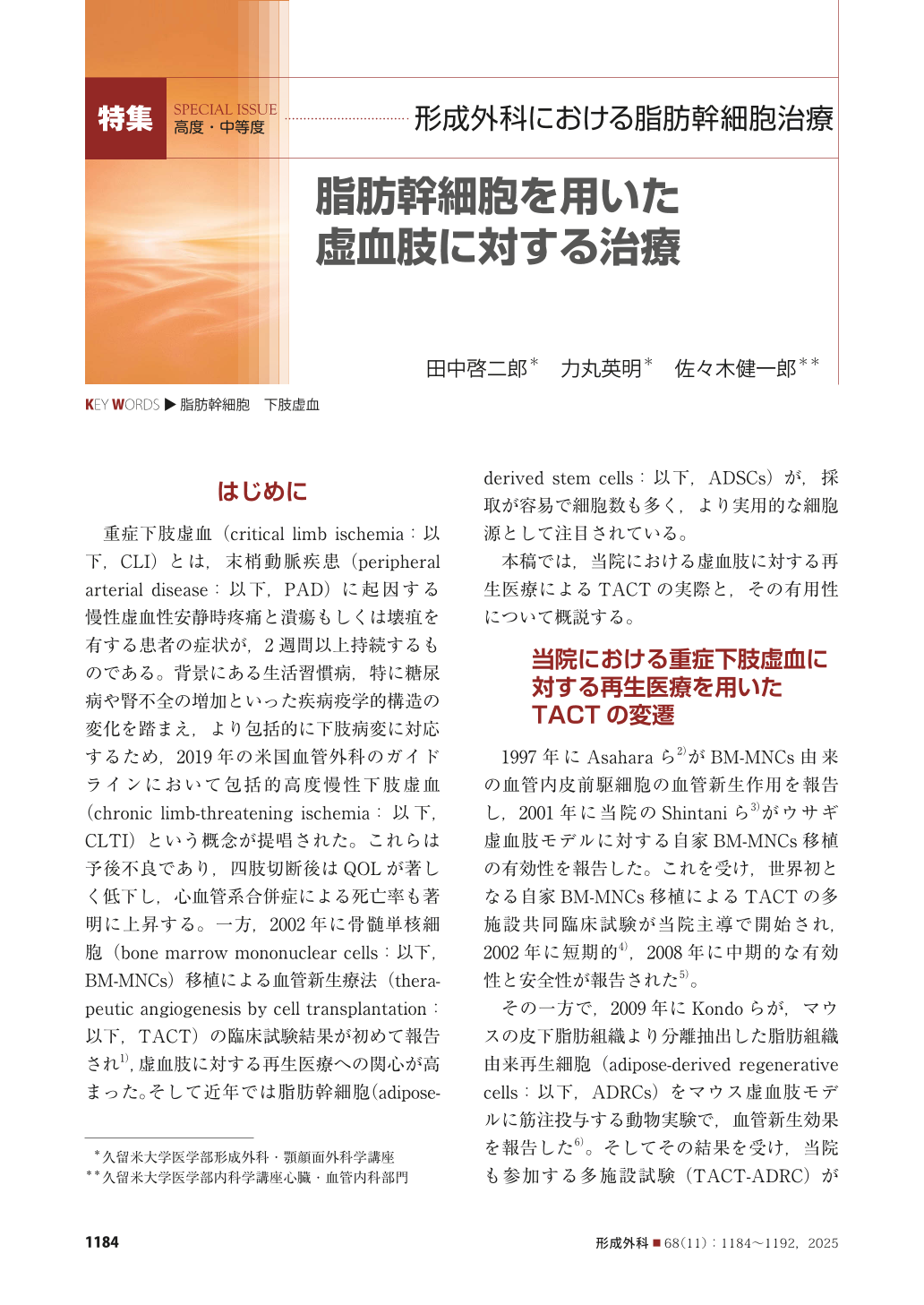Japanese
English
- 有料閲覧
- Abstract 文献概要
- 1ページ目 Look Inside
はじめに
重症下肢虚血(critical limb ischemia:以下,CLI)とは,末梢動脈疾患(peripheral arterial disease:以下,PAD)に起因する慢性虚血性安静時疼痛と潰瘍もしくは壊疽を有する患者の症状が,2週間以上持続するものである。背景にある生活習慣病,特に糖尿病や腎不全の増加といった疾病疫学的構造の変化を踏まえ,より包括的に下肢病変に対応するため,2019年の米国血管外科のガイドラインにおいて包括的高度慢性下肢虚血(chronic limb-threatening ischemia:以下,CLTI)という概念が提唱された。これらは予後不良であり,四肢切断後はQOLが著しく低下し,心血管系合併症による死亡率も著明に上昇する。一方,2002年に骨髄単核細胞(bone marrow mononuclear cells:以下,BM-MNCs)移植による血管新生療法(therapeutic angiogenesis by cell transplantation:以下,TACT)の臨床試験結果が初めて報告され 1),虚血肢に対する再生医療への関心が高まった。そして近年では脂肪幹細胞(adipose-derived stem cells:以下,ADSCs)が,採取が容易で細胞数も多く,より実用的な細胞源として注目されている。
本稿では,当院における虚血肢に対する再生医療によるTACTの実際と,その有用性について概説する。
Chronic limb-threatening ischemia (CLTI) is a severe form of peripheral arterial disease that is characterized by chronic ischemic pain and ulceration or gangrene, often leading to limb amputation. Although surgical or endovascular revascularization is a standard treatment for CLTI, some patients are not eligible for either of these treatments due to anatomical and/or clinical factors. Therapeutic angiogenesis using stem cell transplantation has emerged as a promising alternative. Initially, bone marrow mononuclear cells (BM-MNCs) were used for the angiogenesis, but more recently adipose-derived regenerative cells (ADRCs) and the stromal vascular fraction (SVF) have gained attention due to the easier harvesting of these cell types and their comparable angiogenic potential. At our institution, we have implemented a protocol for the intramuscular injection of SVF isolated from autologous fat tissue. An automated washing and concentration system is used to obtain the SVF. We report the case of a 56-year-old female with Buergerʼs disease that was successfully treated with SVF therapy, resulting in pain reduction, ulcer healing, and improved tissue perfusion. We also note that the Therapeutic Angiogenesis by Cell Transplantation (TACT)-ADRC multicenter study demonstrated a high limb salvage rate with good safety record with SVF therapy. Although the mechanism that underlies the therapeutic effect of SVF treatment remains under investigation, we suspect that the SVFʼs diverse cell population may contribute to angiogenesis, immune modulation, and tissue repair. The present case results suggest that adipose stem cell-based therapy is a feasible and effective option for CLTI patients who are not eligible for other options and may offer a new avenue in regenerative vascular medicine.

Copyright© 2025 KOKUSEIDO CO., LTD. All Rights Reserved.


